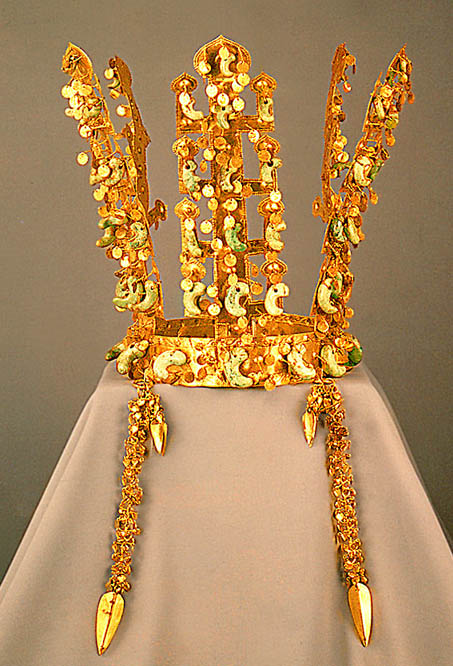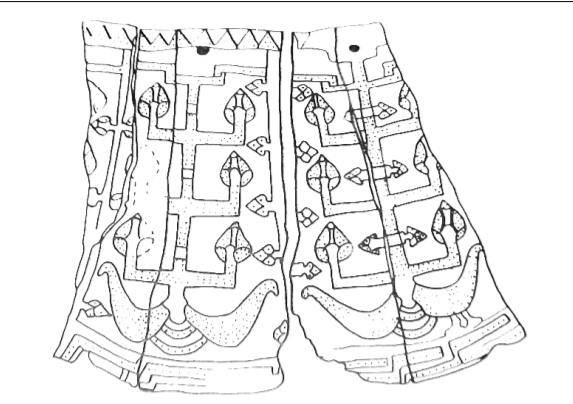

The image of World tree in the Bural of the Ancient period in Baikal Region in the Baikal lake basin and on Korean diadems: the problem/question of cultural contacts on territory of Asia.
In 1984, in Russia, on the Don during excavations, burial grounds dating back to the Khazar time were found. Many interesting things were found there.
In the burial was a female skeleton – 18 or 20 years old. In the burial were a vessel, a jug, a mirror, a ring. There was also a case for storing precious items. We are very interested in drawing on this subject – an artifact. On the surface, the image of the world tree is composed of three symmetrically arranged branches. They end with leaflets. At the base of the trunk are paired symmetrical images of birds. But the lower edge is marked with a meander pattern. A belt of triangles goes along the upper edge. Triangle is a popular ornament in this culture. The body is oriented southwest. Figure number 1 in the appendix.
The closest analogy to this relic in time and cultural affiliation – found at a very different end in Asia and three hundred years earlier – is an image of a world tree on tiaras from Korea. In the southeastern part of Korea in the city of Gyeongju and its environs, I saw the famous golden tiaras of the kingdom of Silla. For this trip and a unique opportunity, I want to say thank you to Mr. President. May God grant him health. These were the territories of the former kingdom of Silla. In the mounds are found gold and bronze tiaras with gold plating and various gold jewelry. These mounds are located compactly, next to each other in the center of the former capital Silla, they are considered royal mounds. Their age is 5th or 6th century AD.
Since the fifth century, the custom has appeared in Silla to put gold objects in burials – earrings, waist belts, head tiaras, rings, slippers and other objects.
These mounds include the northern mound of Huanamdechong (mound No. 98 of the Huanamdong district), Gymguanchong mound (mound near the village of Nosori No. 128), Chonmachong mound (mound No. 155 Hwangnamdong district), Sobongcheong mound.
The idea of a world tree means the idea of a center of the world. Old society revered cosmos. The space needed an explanation and order – which happened through veneration. Orientation in space is the most important condition for human survival. And its existence. The center of the world is the most important element of consciousness without which neither orientation in the world nor successful actions of a very different nature are possible. And in ancient people, sacred and real space were connected. And not like now. The image of space was closely associated with rituals.
The starting point of the universe was the act of creation. The ancient consciousness did not separate the human world from the natural world. And the existence of space without visible efforts was not possible. The ideas of space among people living in Siberia and the South of the Korean Peninsula were expressed in a similar way. The center of society was the center of the world. It is designated by the altar, sanctuary, temple, world tree or world mountain. This world mountain is located near Lake Baikal. The World Tree or the World Mountain is the center of space. The center organizes it vertically – the lower world, the middle world – the earth, the upper world – the sky. The World Mountain is the meeting place of the earthly and heavenly. The three-part universe is repeated in the picture of the world among Siberian people and ancient Koreans.
On the case we see a world tree and symmetrical images of birds. The image of the world tree is on both sides of the case. The birds are fairly sketchy and only one of the four birds has paws. The whole picture (on both sides of the case) consists of three parts and reflects three parts of the universe. The upper world is reflected by triangles on top. The line below indicates the space of the lower world. Direction is indicated counterclockwise.
The middle world is the main part of the image. A world mountain or tree connects all three worlds. This can be seen from the top which opens in the upper world. The world tree is characterized by images of deer or birds marking the middle world and are attributes of the world tree. It is no coincidence that such an item is in the female burial.
Tiaras from the mounds of the Silla era are the most spectacular finds from the royal mounds of the fifth and sixth centuries AD. The main element of the tiaras is the world tree (or mountain) in the center, on the sides there are deer horns, which mean a symmetrical pair of deer. Sometimes images of birds. Tiaras are explained as evidence of the existence of shamanism in Korea.